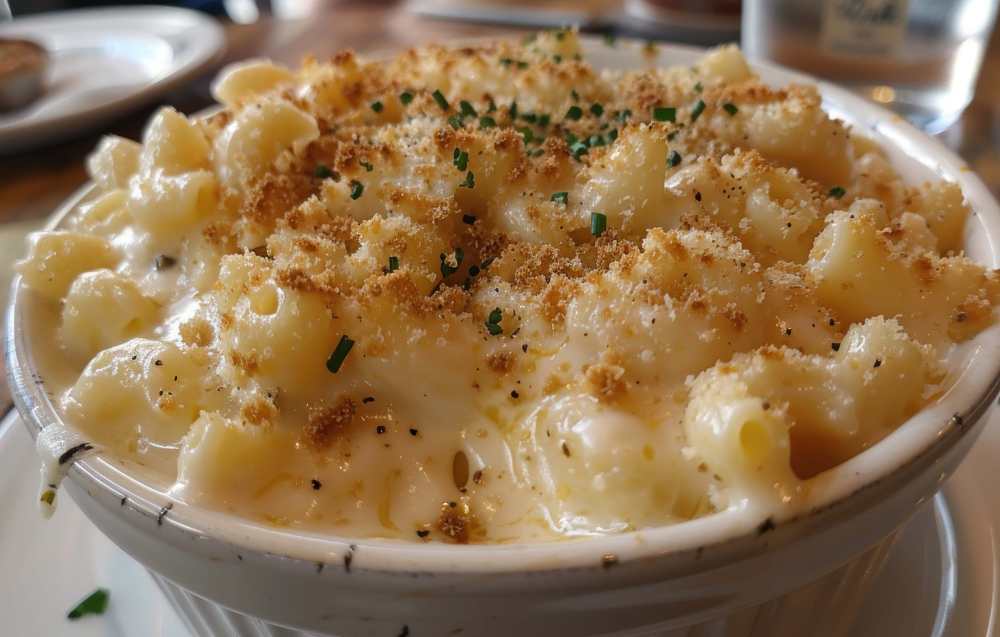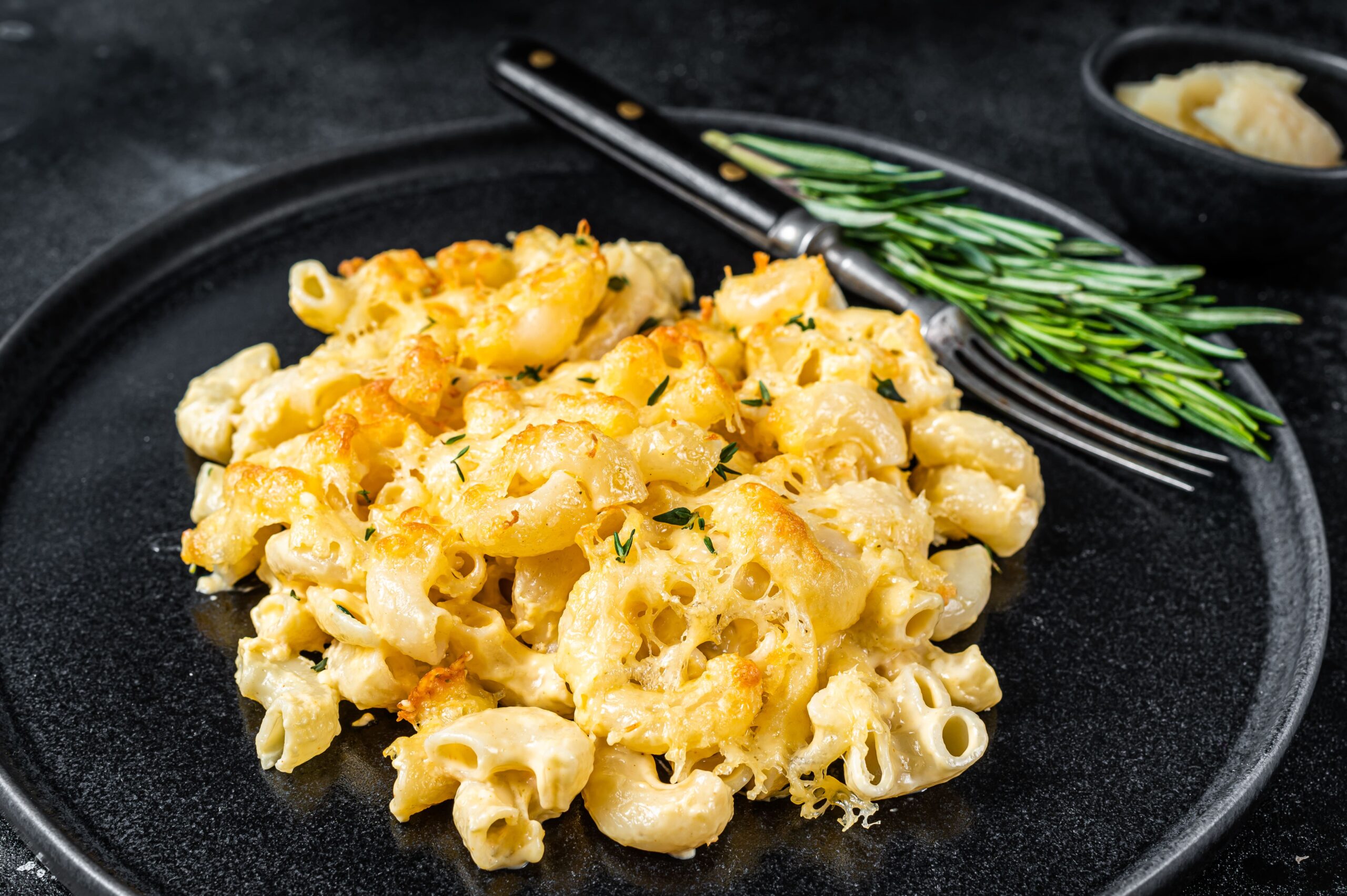Mac and cheese—it’s the ultimate comfort food, isn’t it? Whether you’re making it for a quick weeknight dinner, a potluck favorite, or just to indulge your cheesy cravings, getting the right mix of cheeses can take this dish from average to extraordinary. But what are the three best cheeses for mac and cheese? Let’s dive into the creamy, gooey, flavorful world of cheese to find out.
Introduction: The Art of Perfect Mac and Cheese
Crafting the perfect mac and cheese is like creating a symphony—each ingredient plays its part to build something greater than the sum of its parts. While pasta and sauce matter, the cheese is undoubtedly the star of the show. Get it right, and your mac and cheese will be unforgettable. But get it wrong, and you’ll end up with a clumpy, bland mess.

If you’re looking for a step-by-step guide to elevate your mac and cheese skills, check out the Tini Mac and Cheese Recipe: Your Ultimate How-To Guide for detailed tips.
Why Cheese Selection Matters
Cheese isn’t just an ingredient in mac and cheese; it’s the heart and soul of the dish. The right cheese gives you that creamy texture, gooey melt, and bold flavor. Some cheeses bring sharpness, others offer a smooth and buttery finish, and a few even surprise you with nutty undertones. Choosing wisely ensures that every bite is a little piece of heaven.
The Core Components of a Great Mac and Cheese
Before we dive into cheeses, let’s talk about the backbone of any great mac and cheese: the pasta, sauce, and seasonings.
Pasta: The Foundation
Picking the right pasta might seem trivial, but trust me, it’s not. Macaroni is the classic choice, but other shapes like shells, cavatappi, or penne can hold the sauce just as well. Look for pasta with ridges or hollows—they trap the cheesy goodness in every nook and cranny. For more insights, explore The Best Pasta for Mac and Cheese: Tini’s Guide to Perfection.
Cheese: The Star Ingredient
Your cheese determines the dish’s flavor profile, texture, and creaminess. A good mac and cheese doesn’t rely on just one type of cheese; it blends complementary cheeses to achieve the perfect balance of taste and meltability.
Sauce and Seasonings: Elevating the Flavor
Your sauce is the glue that holds everything together. A roux-based béchamel sauce provides the creamy base, while seasonings like garlic, mustard powder, and paprika add depth. A sprinkle of salt and pepper ensures your flavors pop.
“The secret to unforgettable mac and cheese? It’s all about balance—creamy, sharp, and savory.”
The Top 3 Cheeses for Mac and Cheese
Let’s finally address the cheeses that make this dish extraordinary.
1. Cheddar: The Classic Choice
Cheddar is the Beyoncé of cheeses—it’s a crowd favorite, and for good reason. Its sharp, tangy flavor gives mac and cheese that quintessential cheesy kick we all love. Plus, it melts beautifully, creating a velvety texture. Opt for a medium or sharp cheddar for the best results. Mild cheddar can sometimes taste bland, while extra sharp cheddar may overpower the dish.
2. Gruyère: The Nutty and Creamy Enhancer
Looking to elevate your mac and cheese to gourmet status? Gruyère is your secret weapon. This Swiss cheese has a mild nutty flavor that pairs perfectly with cheddar’s tanginess. It’s creamy, melts effortlessly, and adds a sophisticated touch. Your guests won’t stop asking for your recipe when you include this cheese.
3. Parmesan: The Savory Finisher
Parmesan isn’t just for sprinkling on spaghetti; it’s a game-changer in mac and cheese. Its salty, umami-rich profile deepens the dish’s overall flavor. Parmesan doesn’t melt as smoothly as cheddar or Gruyère, so it’s best used as a finishing touch or mixed in small quantities to avoid clumps.
For more on pairing cheeses for the ultimate culinary experience, visit Best Cheese for Brisket Sandwich: Everything You Need to Know.
“The best mac and cheese isn’t just cheesy—it’s a harmonious blend of flavors and textures.”
How to Combine Cheeses for the Perfect Blend
The secret to a flawless mac and cheese lies in the balance. Using just one type of cheese can result in a dish that’s one-dimensional. By combining complementary cheeses, you’ll get a symphony of flavors and textures.
Balancing Flavor Profiles
Start by mixing a cheese with a strong flavor (like sharp cheddar) with a milder one (like Monterey Jack) to create harmony. Adding a cheese with unique characteristics, such as Gruyère or smoked Gouda, can provide depth and sophistication. The goal is to ensure no single cheese dominates the dish.
Ratios and Proportions to Avoid Overpowering Taste
A general rule of thumb is to use a 2:1 ratio of creamy cheese (cheddar or Monterey Jack) to strong-flavored cheese (Parmesan or Gruyère). This balance ensures your mac and cheese has richness without being overwhelming.
“Think of your cheese blend as a team: each player has a role, and together, they create a winning game.”
For a deeper dive into how cheeses behave during melting, learn about the science behind cheese making and discover what makes some cheeses ideal for mac and cheese.
Common Problems When Choosing Cheeses
Even with great cheese options, mistakes can happen. Let’s explore some common problems and how to avoid them.
Cheese That Doesn’t Melt Properly
Ever ended up with clumps of cheese instead of a smooth sauce? That’s likely due to using a cheese that doesn’t melt well, like feta or goat cheese. These cheeses have low moisture and high acidity, which can lead to a grainy texture.
Overly Salty or Bland Cheese Choices
Cheese can be tricky—some types, like Parmesan or blue cheese, can be overly salty. Others, like mild cheddar or mozzarella, might be too bland on their own. A combination of cheeses ensures you balance strong flavors with subtle ones.
Cheese Texture That Disrupts Consistency
Not all cheeses behave the same when melted. Hard cheeses like Parmesan can leave gritty bits in your sauce if used in excess. On the flip side, super-soft cheeses like Brie can make your sauce too runny if not balanced with firmer cheeses.
Solutions to Cheese Selection Challenges
Now that we’ve identified the problems, let’s talk solutions.
Tips for Ensuring a Smooth and Creamy Sauce
To create a velvety sauce, always grate your cheese. Pre-shredded cheese often contains anti-caking agents that prevent smooth melting. Gradually add the cheese to your béchamel sauce, stirring constantly to avoid clumps.
For help with perfecting your sauce texture, check out these cooking techniques for better sauces to elevate your mac and cheese game.
Mixing in a Stabilizer Like Flour or Cornstarch
If your sauce is too thin or your cheese clumps, a stabilizer like flour or cornstarch can save the day. Mix a tablespoon of flour with a bit of milk to create a slurry, then stir it into your sauce. This helps emulsify the cheese and maintain a creamy consistency.
Experimenting with Cheese Combinations
Don’t be afraid to play around with your cheese blends. Try mixing three-quarters cheddar with a quarter Gruyère for a classic twist, or go bold with equal parts Gouda and Parmesan for a smoky-savory balance.
“Mac and cheese is like life: it’s all about experimenting and finding what works best for you.”
Techniques for Perfectly Melting Cheese
Melting cheese might seem straightforward, but a few techniques can make all the difference.
Using Low Heat to Avoid Clumping
Cheese can be temperamental when exposed to high heat. Keep your burner on low or medium to ensure the cheese melts gently and integrates into the sauce smoothly.
The Importance of Grating Cheese
Whole blocks of cheese might look appealing, but they’re harder to melt. Grating cheese increases its surface area, allowing it to melt faster and more evenly. This simple step can be a game-changer for your mac and cheese.
Adding Dairy Gradually for a Consistent Sauce
Pouring all your milk or cream in at once can shock the cheese, causing it to seize up. Add your dairy gradually, stirring constantly, to create a luscious, cohesive sauce.
Pairing Mac and Cheese with Complementary Ingredients
Cheese may be the star, but the supporting ingredients can elevate your mac and cheese to new heights.
Proteins to Enhance the Dish
Adding proteins like crispy bacon, grilled chicken, or even lobster can transform your mac and cheese into a hearty, gourmet meal. These additions not only provide extra flavor but also balance the richness of the cheese.
Vegetables for Added Texture and Nutrients
Who says mac and cheese can’t be a little healthy? Toss in steamed broccoli, caramelized onions, or roasted tomatoes to add texture and a pop of color. These veggies also cut through the creaminess, giving your dish a fresh twist.
Toppings for a Crispy and Flavorful Finish
The contrast between creamy cheese and a crispy topping is what dreams are made of. Sprinkle breadcrumbs, crushed crackers, or even fried onions on top, then bake until golden brown. For extra flavor, mix Parmesan or paprika into your topping.
For those curious about how mac and cheese became a staple in households, explore the history of mac and cheese to understand its origins as the ultimate comfort food.
levating Your Mac and Cheese Game
Mac and Cheese Around the World: Unique Cheese Varieties
Mac and cheese might feel like a quintessentially American dish, but its variations around the world tell a different story. By drawing inspiration from international cuisines, you can give your mac and cheese a delightful twist that’s anything but ordinary.
Italian-Inspired Variations with Pecorino and Asiago
Italy, the land of cheese and pasta, offers plenty of inspiration for mac and cheese enthusiasts. Pecorino Romano, with its sharp, salty flavor, adds a bold punch, while Asiago brings a nutty creaminess that elevates the dish. Combine these cheeses with rigatoni or ziti, and you’ve got a rich, hearty Italian take on mac and cheese.
French Versions with Brie and Camembert
The French know a thing or two about indulgence, and their approach to mac and cheese is no different. Brie and Camembert add a buttery, earthy flavor that’s luxurious without being overpowering. These cheeses melt beautifully, creating a velvety sauce that pairs well with classic elbow pasta or fusilli.
American Southern-Style Mac and Cheese with Sharp Cheddar
In the Southern United States, mac and cheese isn’t just a dish—it’s a tradition. Sharp cheddar serves as the foundation, creating a bold and tangy flavor. Often baked with a crispy breadcrumb topping, this style adds cream cheese for extra creaminess and a hint of cayenne pepper for warmth. It’s a comforting classic that never goes out of style.
“No matter where you travel, mac and cheese is a dish that speaks the universal language of comfort.”
Nutritional Considerations for Cheese Selection
While mac and cheese is undeniably delicious, it can also be heavy. Balancing indulgence with nutrition doesn’t mean sacrificing flavor—it just requires a few thoughtful adjustments.
Low-Fat Cheese Options
If you’re watching your calorie intake, consider using low-fat versions of your favorite cheeses. Low-fat cheddar, mozzarella, and Swiss are widely available and can help reduce the dish’s overall richness while still delivering great flavor.
Balancing Indulgence with Health
To make mac and cheese more balanced, try incorporating whole-grain or chickpea pasta for added fiber and protein. Mixing in vegetables like steamed spinach, roasted cauliflower, or diced tomatoes can boost both flavor and nutrition. A smaller serving of mac and cheese alongside a crisp green salad is another way to keep things lighter while still satisfying your cravings.
Final Tips for Choosing the Best Cheeses
Picking the right cheeses is the key to creating a mac and cheese masterpiece. By understanding your personal preferences and experimenting with different combinations, you can craft a dish that’s uniquely yours.
Tailoring Your Selection to Personal Preferences
When selecting cheeses, consider what you enjoy most. Do you prefer bold, sharp flavors or mild, creamy ones? For a classic taste, stick with cheddar and Gruyère. If you like smoky notes, Gouda is a great option. And for those who enjoy a touch of funkiness, a small amount of blue cheese can add unexpected depth.
Testing and Perfecting Your Recipe
No two mac and cheese recipes are the same, and part of the fun is testing and tweaking until you find your perfect blend. Start with a base recipe, then gradually adjust the cheese ratios, seasonings, and textures to suit your taste. Take notes along the way so you can recreate your favorite version.
“A great mac and cheese isn’t made—it’s discovered through trial, error, and a whole lot of delicious taste testing.”
Conclusion: Elevate Your Mac and Cheese Game
Mac and cheese is more than a dish—it’s a blank canvas for creativity, a warm hug in a bowl, and a reminder of the joys of comfort food. By experimenting with different cheeses, incorporating unique ingredients, and paying attention to details like texture and flavor balance, you can transform this classic dish into a gourmet experience.
So grab your favorite cheeses, fire up the stove, and let your inner chef shine. Whether you’re making a simple dinner for yourself or impressing guests at a gathering, one thing is certain: with the right cheese and a little love, your mac and cheese will always be a hit.
“Mac and cheese is a celebration of simplicity, creativity, and the undeniable magic of melted cheese.”

